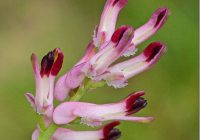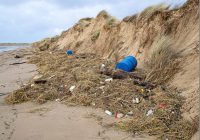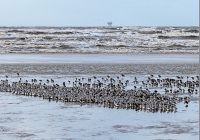Dr Phil Smith’s Wildlife Notes
February 2020
Another record! Last year it was an unprecedented heat-wave, this time it was the wettest February since records began. Three named storms contributed to most places having two or three times their normal rainfall. Here, measurable rain fell on 22 days, though it was prolonged on only three. It was also incredibly windy for long periods. Walking in the wind and rain is not my idea of fun, so my time in the field was limited, especially during the second half of the month.
Despite a horrible wind, I went on 1st with Joshua Styles and Trevor Davenport to check Josh’s re-introduction site for Heath Cudweed at Birkdale Cemetery. We found several seed-heads, showing they had flowered last summer. A remarkable variety of wildflowers included Groundsel, Daisy, Hairy Bitter-cress, Shepherd’s-purse, Spring Whitlow-grass, Thale Cress, Red Dead-nettle and Henbit Dead-nettle. Even more unusual were flowering Bulbous Buttercup and Tall Ramping-fumitory, normally seen in May or June. The fumitory is regionally notable, being largely confined to the west of Britain. We also checked some of graves and headstones for lichens, finding Spiny Heath Lichen Cetraria aculeata and the mainly coastal Cladonia foliacea, amongst others.
In more favourable conditions the following day, I walked through the National Trust’s Larkhill Woods. After being molested by two dogs, I found my target, the appropriately-named Scarlet Elf Cup, a widespread but uncommon fungus. There were about 20 specimens on a mossy log. Singing birds in the woodland included Great Tit, Mistle Thrush and the ubiquitous Robin.
On 3rd, I visited the Birkdale Sandhills Local Nature Reserve (LNR), walking north via Sands Lake where a single Pochard and seven Gadwall made a change from the usual Mallard. My aim was to check out the scrub-control work by Green Sefton staff, working manfully with chain-saws to reverse a decade of relative neglect. It was a daunting task tackling enormous stands of elderly Sea Buckthorn that has invaded the dunes east of the coast road. Similar work west of the road during this period by the volunteer Buckthorn Bashers has produced a landscape, largely free of this introduced menace, though there is still regrowth to cut with hand-tools. Up to 16 of our dedicated volunteers met four times during the month.
I was pleased to see that Gems in the Dunes staff and volunteers have also done great work on the Ainsdale Sandhills LNR, taking out some big patches of Sea Buckthorn,while also hand-digging a new Natterjack Toad scrape.
Storm Ciara coincided with 10 m tides. Fearing the worst, I went to Hightown on 11th while a force 9 storm was still raging. It was hard to stand upright but I managed to photograph the damage to the frontal dunes, estimating about 7 m of loss, except where brick rubble “shingle” has protected the dune frontage. In places rubble was deposited on the fore-dunes by the force of the waves, while the huge amounts of washed-up plastic reminded me of the last big storm-surge in December 2013. Ironically, the largest item I found was a plastic recycling bin from “Manchester City Council”.
In contrast, there was hardly any erosion to the Green Beach dunes north of Ainsdale-on-Sea. This demonstrates the benefits of a wide, gently shelving foreshore that reduces wave action. About 1000 gulls were roosting on the beach, including a few Scandinavian Herring and Lesser Black-backed Gulls, while a sizeable wader flock, soon to be flushed by dog-walkers, had over 1000 Sanderling, together with hundreds of Dunlin and a few Grey Plover and Knot.The outer shores of the Ribble Estuary are the most important wintering area in Britain for the Sanderling, a tiny wader that flies the Atlantic twice a year to and from its breeding grounds in Greenland and Northern Canada.
It was another dreadfully windy day on 24th, when I visited Crosby Coastal Park in the hope of seeing a Spotted Redshank that Pete Kinsella had reported on previous days. It should be wintering in Africa. Disappointingly, there was no sign of it, though the long-staying Long-tailed Duck was still on the small boasting lake with six Goldeneye and 17 Tufted Ducks. A Turnstone was unexpected, as was a flock of about 350 Oystercatchers on the park grassland.
Finally, late in the month, the first of the new Dynamic Dunescapes projects removed some of the pine and birch that has invaded the dune heathland of the Montagu Road Triangle at Freshfield. Two tracked machines piled up masses of brash ready to chip for use at the nearby Clover-le-Dale farm.





